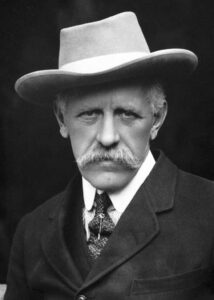Fridtjof Nansen
1861-1930

Fridtjof Nansen was a Norwegian Arctic explorer, oceanographer, and public figure. He was born on October 10, 1861 in the Sture-Freen estate near Kristiania (now it is Oslo). After graduating from the University of Kristiania (1882), Nansen made a voyage on the Viking hunting vessel as a sailor. In 1884 he was appointed curator of the Zoology Department at the Bergen City Museum. In 1888, Nansen and five comrades landed on the coast of Greenland near Angmagsalik and, having first crossed the island from east to west on skis, established the fact of continuous glaciation of its interior. Upon his return, he worked at the University of Kristiania. He received the position of professor in 1897. In 1890, Nansen set out to get to the North Pole on a ship drifting with the ice. On June 24, 1893, the expedition set off from Vadse (Norway) on the ship «Fram». The ship rounded Cape North Cape, passed near the northern tip of Siberia and he found himself in the pack ice behind Cape Chelyuskin on September 28, 1895. Nansen decided to get as close to the pole as possible on a sledge. However, the researchers had to return, and after wintering on Franz Josef Land, they arrived in Vadse on August 13, 1896. A few days later, the «Fram» returned safely to Norway. Nansen spent a long time processing the results of the expedition, found a method for determining the flow velocities from a drifting vessel, designed a barometer and an accurate hydrometer. Then he participated in an expedition that studied the currents in the Arctic Ocean (1900) and made a number of other voyages for scientific purposes. In 1902 he established an oceanographic laboratory in Kristiania. In 1906-1908 he was Ambassador to Great Britain. At the end of the First World War, he was the representative of Norway to the United States, the High Commissioner of the League of Nations for Prisoners of War (1920-1921), became one of the organizers of international aid to the starving of the Volga region (1921). In 1922, as High Commissioner for Refugees, he established a special (Nansen) passport bureau. In 1922 the researcher was awarded the Nobel Peace Prize. A number of geographical objects in the Arctic and Antarctic are named after Nansen.
Address: Moscow, Bolshoy Levshinsky lane, 6, p. 1

